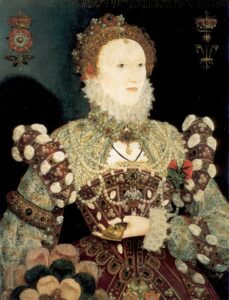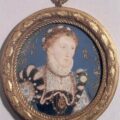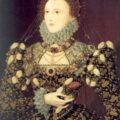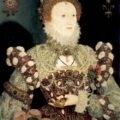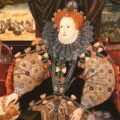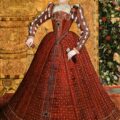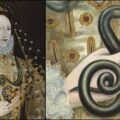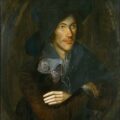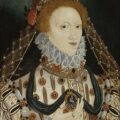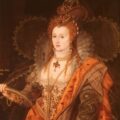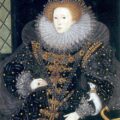Thank you so much for all of your comments regarding symbolism in the Armada portrait, I still can’t figure out whether it’s a pomegranate or a finial behind Elizabeth, but it’s great fun discussing these portraits and puzzling them out.
Today, we’re going to look at the famous Pelican Portrait thought to have been painted by Nicholas Hilliard in around 1574/1575, when Elizabeth was in her forties. What symbols can you see in this one and what is Elizabeth saying through the portrait? I’ll start you off and then please add your ideas and finds in the comment section below.
Symbolism in the Pelican Portrait
- Two imperial crowns – The crown on the left hand side of the picture is sitting on top of a Tudor rose and therefore symbolizes Elizabeth’s claim to England and the crown on the right hand side is sitting on top of a Fleur de Lys and so symbolizes Elizabeth’s claim to France.
- The Pelican – Elizabeth is wearing a “pelican in her piety” pendant on her breast and this symbolizes her selfless love for her people, a mother’s love, because, according to legend, a female pelican would pluck her own breast to feed her dying young with her own blood. Also, as I said a couple of weeks ago, the pelican was also a symbol, in the Middle Ages, of Jesus’ crucifixion, the ultimate sacrifice, and of the Eucharist, the feeding of his followers with his own body and blood.
- The colours of Elizabeth’s clothing – The National Maritime Museum point out that this portrait shows Elizabeth dressed in red, black, white and gold, colours that spoke of her wealth and status. Red fabric was dyed using cochineal, a dye restricted to those with serious money, and black fabric was notoriously expensive.
- Tudor roses – As well as the Tudor Rose in the top right hand corner, you can also see Tudor Roses in the blackwork embroidery on Elizabeth’s sleeves and partlet. Even though Elizabeth has been queen for a while, she is reaffirming her Tudor roots and her right to the English throne.
- Pearls – There are pearls on Elizabeth’s headdress, on her dress, and around her neck and shoulders, lots of them in fact. These symbolized Elizabeth’s purity and virginity.
I couldn’t figure out what Elizabeth was holding, is it a pair of gloves? Not sure.
What can you see in the portrait?
